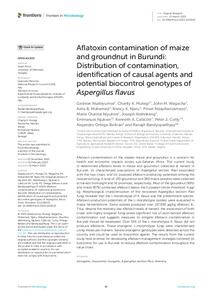| dc.contributor.author | Nsabiyumva, G. |
| dc.contributor.author | Mutegi, C. |
| dc.contributor.author | Wagacha, M. |
| dc.contributor.author | Mohamed, A.B. |
| dc.contributor.author | Njeru, N.K. |
| dc.contributor.author | Ndayihanzamaso, P. |
| dc.contributor.author | Niyuhire, C. |
| dc.contributor.author | Atehnkeng, J. |
| dc.contributor.author | Njukwe, E. |
| dc.contributor.author | Callicott, K. |
| dc.contributor.author | Cotty, P. |
| dc.contributor.author | Ortega-Beltran, A. |
| dc.contributor.author | Bandyopadhyay, R. |
| dc.date.accessioned | 2023-10-15T16:56:03Z |
| dc.date.available | 2023-10-15T16:56:03Z |
| dc.date.issued | 2023-03-13 |
| dc.identifier.citation | Nsabiyumva, G., Mutegi, C., Wagacha, M., Mohamed, A.B., Njeru, N.K., Ndayihanzamaso, P., ... & Bandyopadhyay, R. (2023). Aflatoxin contamination of maize and groundnut in Burundi: distribution of contamination, identification of causal agents and potential biocontrol genotypes of Aspergillus flavus. Frontiers in Microbiology, 14: 1106543, 1-13. |
| dc.identifier.issn | 1664-302X |
| dc.identifier.uri | https://hdl.handle.net/20.500.12478/8284 |
| dc.description.abstract | Aflatoxin contamination of the staples maize and groundnut is a concern for health and economic impacts across sub-Saharan Africa. The current study (i) determined aflatoxin levels in maize and groundnut collected at harvest in Burundi, (ii) characterized populations of Aspergillus section Flavi associated with the two crops, and (iii) assessed aflatoxin-producing potentials among the recovered fungi. A total of 120 groundnut and 380 maize samples were collected at harvest from eight and 16 provinces, respectively. Most of the groundnut (93%) and maize (87%) contained aflatoxin below the European Union threshold, 4 μg/kg. Morphological characterization of the recovered Aspergillus section Flavi fungi revealed that the L-morphotype of A. flavus was the predominant species. Aflatoxin production potentials of the L-morphotype isolates were evaluated in maize fermentations. Some isolates produced over 137,000 μg/kg aflatoxin B 1 . Thus, despite the relatively low aflatoxin levels at harvest, the association of both crops with highly toxigenic fungi poses significant risk of post-harvest aflatoxin contamination and suggests measures to mitigate aflatoxin contamination in Burundi should be developed. Over 55% of the L-morphotype A. flavus did not produce aflatoxins. These atoxigenic L-morphotype fungi were characterized using molecular markers. Several atoxigenic genotypes were detected across the country and could be used as biocontrol agents. The results from the current study hold promise for developing aflatoxin management strategies centered on biocontrol for use in Burundi to reduce aflatoxin contamination throughout the value chain. |
| dc.description.sponsorship | United States Agency for International Development |
| dc.description.sponsorship | Bill & Melinda Gates Foundation |
| dc.format.extent | 1-13 |
| dc.language.iso | en |
| dc.subject | Maize |
| dc.subject | Food Security |
| dc.subject | Biological Control |
| dc.subject | Aspergillus Flavus |
| dc.subject | Biodiversity |
| dc.subject | Value Chain |
| dc.subject | Aflatoxins |
| dc.title | flatoxin contamination of maize and groundnut in Burundi: distribution of contamination, identification of causal agents and potential biocontrol genotypes of Aspergillus flavus |
| dc.type | Journal Article |
| cg.contributor.crp | Maize |
| cg.contributor.affiliation | Institut des Sciences Agronomiques du Burundi |
| cg.contributor.affiliation | International Institute of Tropical Agriculture |
| cg.contributor.affiliation | University of Nairobi |
| cg.contributor.affiliation | Kenya Agricultural and Livestock Research Organization |
| cg.contributor.affiliation | United States Department of Agriculture, Agricultural Research Service |
| cg.contributor.affiliation | Ocean University of China |
| cg.coverage.region | Africa |
| cg.coverage.region | Central Africa |
| cg.coverage.country | Burundi |
| cg.coverage.hub | Eastern Africa Hub |
| cg.coverage.hub | Central Africa Hub |
| cg.coverage.hub | Headquarters and Western Africa Hub |
| cg.researchtheme | Plant Production and Health |
| cg.identifier.bibtexciteid | NSABIYUMVA:2023 |
| cg.isijournal | ISI Journal |
| cg.authorship.types | CGIAR and developing country institute |
| cg.iitasubject | Aflatoxin |
| cg.iitasubject | Agronomy |
| cg.iitasubject | Biodiversity |
| cg.iitasubject | Disease Control |
| cg.iitasubject | Food Security |
| cg.iitasubject | Maize |
| cg.iitasubject | Plant Breeding |
| cg.iitasubject | Plant Diseases |
| cg.iitasubject | Plant Health |
| cg.iitasubject | Plant Production |
| cg.iitasubject | Value Chains |
| cg.journal | Frontiers in Microbiology |
| cg.notes | Open Access Journal; Published online: 13 Mar 2023 |
| cg.accessibilitystatus | Open Access |
| cg.reviewstatus | Peer Review |
| cg.usagerightslicense | Creative Commons Attribution 4.0 (CC BY 0.0) |
| cg.targetaudience | Scientists |
| cg.identifier.doi | https://doi.org/10.3389/fmicb.2023.1106543 |
| cg.iitaauthor.identifier | Charity Mutegi: 0000-0002-3188-0480 |
| cg.iitaauthor.identifier | Emmanuel NJUKWE: 0000-0002-1575-1814 |
| cg.iitaauthor.identifier | Alejandro Ortega-Beltran: 0000-0003-3747-8094 |
| cg.iitaauthor.identifier | Ranajit Bandyopadhyay: 0000-0003-2422-4298 |
| cg.futureupdate.required | No |
| cg.identifier.issue | 1106543 |
| cg.identifier.volume | 14 |

